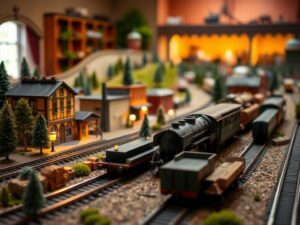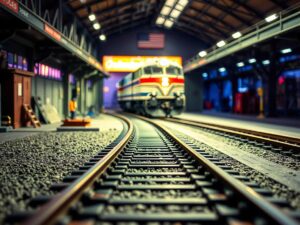Designing Urban Layouts for HO Scale Trains
Designing Urban Layouts for HO Scale Trains
Designing Urban Layouts for HO Scale Trains
Welcome back, fellow train enthusiasts! Today, we’re diving headfirst into the exhilarating world of urban HO scale layout design. Cityscapes brimming with detailed buildings, bustling street life, and intricate infrastructure â thereâs nothing quite like creating a miniature metropolis that pulsates with rail-powered activity.
Whether you’re a brand new hobbyist or a seasoned builder looking to expand your urban railroad horizons, this guide will provide a wealth of information and inspiration to help you craft the cityscape of your dreams in HO scale.
Laying the Foundation: Planning Your Urban Oasis
Before we delve into the nitty-gritty of track layouts and buildings, let’s establish some fundamental planning principles:
- Scale is King: Remember, we’re working with HO scale, where 1 inch represents 87 feet in real life. This means your cityscape will be compact but incredibly detailed. Plan meticulously, keeping accurate scales and dimensions for structures, vehicles, and track placement.
- Theme and Story: What kind of urban environment are you envisioning? A bustling industrial hub? A charming Victorian district? Or perhaps a modern metropolis with skyscrapers reaching for the sky? Define your theme early on, as it will guide your building choices, landscaping decisions, and overall aesthetic.
- Functionality First: While aesthetics are crucial, prioritize operational functionality. Design an efficient layout that allows for smooth train traffic flow. This means strategically positioning stations, yards, sidings, and turnouts to avoid collisions and congestion.
The Track Master: Designing a Rail Network
Now, let’s lay down the backbone of your urban realm â the tracks! Here are some tips for creating an engaging rail network in your HO scale cityscape:
- Loop Tracks: A continuous loop track offers uninterrupted train travel. Consider incorporating several loops of varying sizes to accommodate different types of trains and operations.
- Staging Yards: Provide a dedicated area behind the layout (known as the “backscene”) for storing trains waiting for their turn on the main lines. This adds realism and reduces clutter in your urban core.
-
Turnouts and Switches: Carefully position switches to allow you to control train movement, direct locomotives into different tracks, or create realistic scenarios like sidings and industrial spurs.
-
Urban Routing: Incorporate elements that reflect real-world city rail networks, such as elevated lines, subway tunnels (for which specialized models exist!), bridges, and viaducts. This adds visual interest and complexity to your layout.
The Building Blocks: Bringing the City to Life
With a functional track plan in place, itâs time to bring your cityscape to life with meticulously crafted buildings!
-
Research and Variety: Study actual city architecture for inspiration. Explore different architectural styles prevalent in your chosen theme (e.g., Art Deco, Victorian, Mid-Century Modern).
Remember to mix building heights and scales for a realistic, multi-layered urban landscape. -
Kits vs. Scratch Building: Consider your skill level and budget. Pre-built kits offer excellent starting points with pre-cut components. Scratch building from scratch allows greater customization but requires more advanced skills.
-
Texturing Magic: Don’t forget the details! Employ techniques like weathering, paint washes, and dry brushing to create authentic textures and ages for your buildings, reflecting sun damage, wear and tear, and dust accumulation.
- Miniature Detailing: Go beyond simple structures. Add flourishes like signs, awnings, antennas, windowpanes, lamp posts, and even tiny parked cars. These subtle touches truly bring a city to life.
Landscaping Your Metropolis: From Sidewalks to Streetscapes
Landscaping elevates your urban model railroad from a static display to a vibrant, dynamic environment.
-
Street Design: Plan out a network of roads with varying widths and textures using materials like ballast (ground stone), asphalt sheet, or even pre-painted plastic strips.
Mark crosswalks with tiny yellow stripes for added realism. -
Sidewalk Scene: Utilize narrow strip wood to represent sidewalks alongside your buildings. Incorporate mini benches, flower boxes, mailboxes, and trash cans â those little details make a big difference!
-
Paved Paradise: Create parks, plazas, or rooftop gardens using a combination of foam insulation for the base, textured plaster (e.g., Aves Apoxie Sculpt), sand for texture, and carefully chosen foliage (avoiding too many lush trees in a city setting).
-
Trees on Urban Scale: Choose smaller deciduous trees to maintain visual clarity and avoid overwhelming the cityscape. Cluster them strategically around parks and along roadways for natural beauty within the urban sprawl.
Lighting Up the Night: Adding Visual Impact
Donât forget the power of illumination! Strategically placed lighting can dramatically enhance your city’s nighttime atmosphere.
- Ambient Lighting: Install soft, warm white LEDs to illuminate buildings from the inside, casting a gentle glow across the cityscape.
-
Street Lamps: Create rows of mini street lamps along sidewalks using commercially available LED post lights or by modifying existing small models with LEDs.
-
Beaconing Buildings: Emphasize landmark buildings (e.g., skyscrapers) by adding bright, colorful accent lighting or even rotating searchlights for dramatic effect.
Conclusion: Unleash Your Urban Masterpiece!
Designing an urban HO scale layout is a rewarding journey that blends creative passion with technical mastery. From meticulous track planning to intricately crafted buildings and evocative landscaping, each element contributes to the immersive experience of your miniature city.
Don’t be afraid to experiment, explore different styles, and incorporate unique touches that reflect your personal vision. Remember, the world is your oyster! Start planning, sketching, building, and watch as your urban dream takes shape.
Now, tell me about your aspirations for your own HO scale cityscape. Do you have a particular theme in mind? What elements are you most excited to bring to life? Share your thoughts and let’s discuss further!





